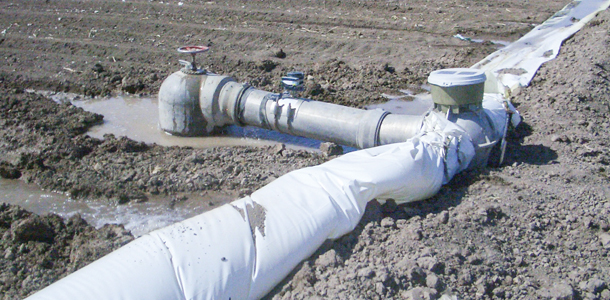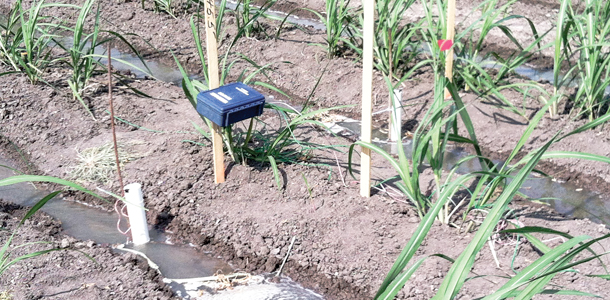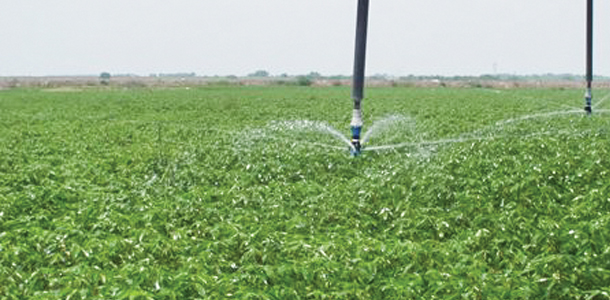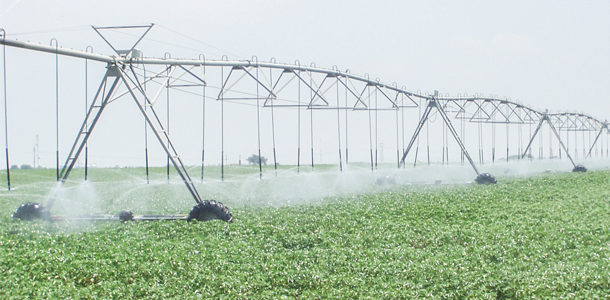The Texas Water Development Board forecasts water needs for all use categories in a state water plan at the end of each five-year regional planning cycle.
In the latest plan published in 2012, water demand projection for agricultural irrigation was 38.1 percent of the total needs estimated for the year 2060.
Some of the irrigated crops in Texas are cotton, vegetables, fruit, grain and forage crops that include wheat, oats, corn, sorghum, hay grazers, alfalfa and grass pastures.
Irrigation water conservation projects have been organized and implemented by organizations, growers and researchers across the state to reduce water needs through better management.
Grower fields were selected as study sites that have diverse site descriptions, cropping systems, crop types and irrigation methods. The demonstrations utilize a combination of real-time innovative water monitoring technologies such as AquaSpy, John Deere Water and PivoTract.
Rio Grande Valley
The Texas State Historical Society describes the Rio Grande Valley as a complex economic and perceptual region. What Texans call “the Valley” centers on Starr, Cameron, Hidalgo and Willacy counties in the lower Rio Grande region and extends from the mouth of the Rio Grande up the river for a distance of some 100 miles.
The lower Rio Grande contains good agricultural land, the region being a true delta and the soils alluvial, varying from sandy and silty loam to clay.
Cotton, grain sorghums and sugarcane are grown in the Valley, and the region is the center of citrus production. It is also the most important area of vegetable production in the state.
“We completed 10 years of demonstrations in the Rio Grande Valley and learned that changing types of irrigation systems does not necessarily conserve water,” states Wayne Halbert, general manager of the Harlingen Irrigation District. “Good management is a key requirement for saving water.
A drip-irrigation customer used more water on a per-acre basis in our district than growers with flood and other types of systems.
 “Many turnouts in surface-water systems deliver around 1,000 gallons of water per minute. Our data shows that 2,000 to 3,000 gallons per minute at turnout provides a farmer the opportunity to be much more efficient by allowing him to keep personnel in the field to better manage his irrigation.
“Many turnouts in surface-water systems deliver around 1,000 gallons of water per minute. Our data shows that 2,000 to 3,000 gallons per minute at turnout provides a farmer the opportunity to be much more efficient by allowing him to keep personnel in the field to better manage his irrigation.
“Sensor-controlled gates were installed in our canals to ensure availability of a constant water supply for our customers on a 24-hour basis,” Halbert says. “This aids the grower in properly managing irrigation because water is available when needed."
"Laser-level fields are important for efficient management of irrigation water as well. Growers are also conserving water by irrigating soil 6 to 12 inches deep, the root zone of most crops, rather than saturating soils at deeper levels.”
Northern Panhandle
“The Texas High Plains or Panhandle is one of the most productive agricultural regions in the world,” says Justin Weinheimer, crop improvement director for the United Sorghum Checkoff.
“Fertile soils, favorable growing conditions and irrigation water from the Ogallala aquifer has allowed the Texas High Plains to become an important food and fiber production region in the Southern Great Plains.
Crop production plays a crucial role in the Texas High Plains economy and provides the economic engine for the region.
“Within the Texas High Plains, there are two distinct agricultural production regions separated north to south by topography, climate and hydrologic characteristics. The northern portion, referred to as the Northern Panhandle, is more suited for grain production, while the southern portion, the South Plains, produces a variety of crops with cotton rotations as the predominant enterprise.”
The North Plains Groundwater Conservation District is located in the Northern Panhandle and serves all or portions of eight counties. District personnel initiated 200-12 Project in 2010 as a five-year, commercial-scale, field demonstration program with a goal to produce 200 bushels of corn on 12 inches or 325,851 gallons of water per acre.

The goal is based on the region’s average annual rainfall of approximately 12 inches, combined with 6 inches of soil moisture and 12 inches irrigation to provide a total of approximately 30 inches of water to the crop.
“The district believes the 200-12 demonstrations will show that reducing irrigation by 6 inches under normal growing conditions can be reasonably accomplished,” says Kirk Welch, North Plains Groundwater Conservation District.
“The idea is to show how using new technologies combined with tried-and-true practices allow producers to reduce groundwater use and remain profitable and financially viable with restricted and diminishing groundwater resources. Our demonstration methods are transferable to other crops.
“By using real-time technologies to monitor soil-water conditions in the root zone, all nine demonstrations showed that growers can manage their irrigation water needs better and reduce crop irrigation,” Welch continues.
“We learned that corn planted in May and June offers reduced seasonal irrigation and is a practice that many growers can apply. It was learned that residue is essential and promising drought-tolerant hybrids performed well.
“Irrigation systems must get more of the available water to the crop, and growers must focus on crop production per inch of water, not maximum yield.
Growers can improve management practices by timing pre-plant irrigation more effectively. We must be more alert and responsive to advanced weather forecasts and reduced soil-water conditions in relation to irrigation capacity.”
South Plains
“The High Plains Underground Water Conservation District No. 1 is located in the South Plains and serves 16 counties,” says Rick Kellison, project director, Texas Alliance for Water Conservation (TAWC).
“Within the district, TAWC has worked during the past seven years with producers on demonstration projects to monitor water use, soil moisture, crop productivity and economic return on various cropping systems."
 "Methods of irrigation water conservation were discussed during a water college held during January of this year. Field walks are conducted on a regular basis to provide opportunities for observation of improved water management and one-on-one discussions on the demonstrated techniques."
"Methods of irrigation water conservation were discussed during a water college held during January of this year. Field walks are conducted on a regular basis to provide opportunities for observation of improved water management and one-on-one discussions on the demonstrated techniques."
“Benefits from the demonstrations include, but are not limited to, measurement of total water savings by individual sites, profitability comparisons to traditional irrigation methods and alternative production strategies that aid in conservation of the Ogallala Aquifer."
"The innovative approach of this project has the potential to impact 4.5 million acres of irrigated cropland throughout the Texas High Plains. Based on the current estimates of irrigation application rates, this project could reduce water demand by as much as 10 percent, or 580,000 acre-feet, annually and approximately 1.75 million acre-feet over the 10-year life of the project.”
“Historically, conservation practices have been funded through programs such as the Environmental Quality Incentives Program and the Agricultural Water Enhancement Program,” says Weinheimer.
“In the Texas High Plains, much of the funding for these programs has gone toward cost-sharing of infrastructure related to center pivots and subsurface drip systems."
"These investments in an irrigation infrastructure have allowed farmers to increase their irrigation efficiencies, which create effective water delivery without losses to evapotranspiration. Increased water efficiency, however, does not necessarily translate to water conservation.”
To achieve conservation of water resources, there is a need to implement water management practices that target the application of irrigation to meet a crop’s water requirements while optimizing production and profitability.
The combination of efficient irrigation systems and strategic irrigation management will help maximize return on investment in conservation practices.
“Strategic irrigation management involves timely application of proper quantities of water to optimize production within a cropping system based on resource constraints,” Kellison says.
“Strategic irrigation management incorporates use of various technologies to measure crop water demand, soil moisture availability, irrigation application rates and precipitation received."
"In addition, crop system management should take into account residue management, nutrient management, variety selection, planting density, pest management and other best management practices.” FG
Robert Fears is a freelance writer based in Texas.
PHOTOS
PHOTO 1: A pivot irrigation system with nozzles placed just above the crop helps manage water use efficiency.
PHOTO 2: Turnout flows of 2,000 to 3,000 gallons of water per minute help growers better manage irrigation water in the Rio Grande Valley of Texas.
PHOTO 3: Soil moisture meters are some of the instruments being used by irrigation districts to help growers more efficiently use water.
PHOTO 4: Irrigation sprinklers placed lower to the ground reduce water evaporation. Photos courtesy of Tom McLemore, Harlingen Irrigation District, Harlingen, Texas.











